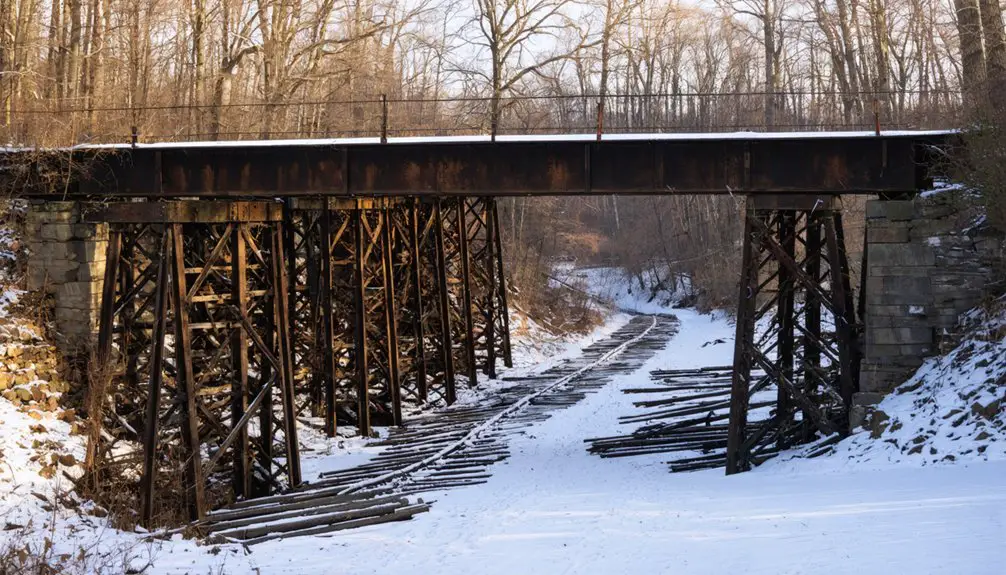You’ll find Mandan’s haunting remains in Michigan’s Upper Peninsula, where this once-bustling copper mining town flourished from 1863 until 1909. The settlement grew around the Mandan and Medora mines, becoming a crucial railroad hub with hundreds of residents, stores, and boarding houses. Today, only scattered cement foundations and silent mine shafts mark where multicultural miners once extracted precious copper. The site’s rich history holds countless stories of triumph, tragedy, and unexplained phenomena.
Key Takeaways
- Mandan became a ghost town after its copper mines closed in 1909 and railroad operations ceased in 1918, ending its economic viability.
- The town’s remnants include scattered cement foundations of its downtown area and preserved seasonal homes from early 1900s mining architecture.
- Mandan was established in 1863 following copper discoveries, becoming a major mining center with the Mandan and Medora mines.
- Local legends tell of ghostly miners, phantom trains, and mysterious lantern lights around the abandoned mines and railroad depot.
- Visitors must obtain permission to explore the site, as it’s private property, and should avoid unstable foundations for safety.
The Rise of a Mining Settlement
When the Mandan Mining Company organized in 1863 after discovering a rich copper vein, it marked the beginning of a significant mining settlement in Michigan’s Keweenaw Peninsula.
You’ll find that mining operations commenced quickly, with two primary shafts – the Mandan and Medora mines – becoming the heart of the burgeoning community.
Despite facing mining challenges from narrow veins and troublesome sand beds, the settlement attracted hundreds of residents by the early 1900s.
Similar to the trading prowess of the indigenous Mandan people, the settlement developed into a major commercial center for the region.
You can trace the community growth through the establishment of essential services, including a post office and general store.
The arrival of the Keweenaw Central Railroad transformed Mandan into a crucial transportation hub, connecting the settlement to broader markets and facilitating the movement of copper and supplies throughout the region.
The mine experienced various ownership changes until Keweenaw Copper Company acquired both the Mandan and Medora operations in 1899.
Life During the Copper Boom Years
During the height of copper mining operations, life in Mandan centered around the demanding rhythms of underground work and a growing multicultural community.
You’d find miners descending into hazardous shafts for long shifts, using hand drills and black powder while their families struggled with scarce resources and basic necessities.
The town’s diverse population, including Cornish, Finnish, Irish, and German immigrants, maintained their distinct cultural traditions through churches and fraternal organizations. The Ojibwe people had originally inhabited these mineral-rich lands before European settlers arrived.
Despite tough conditions, you’d see community events, local dances, and mutual aid societies bringing people together.
While mine owners and superintendents lived comfortably, most residents faced economic instability from seasonal work and low wages. The miners often dealt with inconsistent income as production was irregular across many Michigan copper mines.
Women and children contributed through cooking, laundry, and small businesses, helping families survive in this rugged mining settlement.
Mining Operations and Technology
You’ll find that Mandan’s copper extraction relied on standard 19th-century mining tools, including manual drills, black powder explosives, and mechanical hoisting equipment to access the narrow veins.
The Medora Mine locality was a significant operation in Grant Township where these extraction methods were employed. The mine’s single main shaft penetrated challenging layers of sand to reach copper deposits as thin as four inches, requiring precise excavation techniques and careful shaft-timbering.
By 1866, persistent issues with sand lenses surrounding the copper vein forced the operation to close, highlighting the geological complexities miners faced.
Working in these confined underground spaces, miners employed stamp mills and processing equipment to crush and separate the copper ore before transport via the Keweenaw Central Railroad.
Mine Equipment and Tools
As mining operations expanded in Mandan, the evolution of equipment and tools transformed primitive extraction methods into sophisticated industrial processes. Mining innovations progressed from basic hammerstones and copper wedges to advanced drills and steam-powered hoists.
You’d find tool evolution reflected in every aspect of the operation, from extraction to processing. Deep shaft mining required robust support systems, including timber bracing and water pumps to prevent flooding. Operations focused primarily on two mine sites, the Mandan and Medora, which were organized in 1864.
You’d see extensive rail networks and conveyor systems moving ore from the depths to sorting stations and smelting furnaces. The remains of the towering stone chimney from the copper furnace still stand today as evidence of the site’s industrial heritage. The introduction of ventilation equipment and improved lighting enhanced safety underground.
While early miners relied on simple hand tools and fire-setting techniques, later operations utilized industrial-scale machinery to process ore more efficiently and reach depths exceeding 6,000 feet.
Underground Excavation Methods
Underground mining in Mandan employed multiple sophisticated extraction methods to reach the region’s deep mineral deposits. As surface mining became impractical, operators turned to sublevel caving techniques, utilizing networks of tunnels and raises to access ore bodies. This method allowed for efficient extraction through controlled cave-ins and systematic removal of broken ore. Heavy equipment like longhole drill jumbos were essential for creating the blast holes needed for ore extraction.
For areas with irregular mineral deposits, miners implemented drift fill approaches. You’ll find evidence of this method in Mandan’s remaining tunnel networks, where crews excavated parallel drifts before backfilling them with waste rock. Room and pillar mining was also utilized in certain sections to provide additional structural support while extracting valuable minerals.
This technique proved essential for maintaining ground stability while maximizing ore recovery. The combination of these methods helped Mandan’s mines achieve high production rates until economic factors ultimately led to their closure.
Daily Life in Historic Mandan
Life in historic Mandan revolved primarily around the copper mining operations that sustained its peak population of 300 residents.
You’d find community gatherings centered at the general store and two boarding houses, where miners and travelers crossed paths during the warmer months. Daily survival proved challenging, as you couldn’t rely on local agriculture due to poor sandy soil.
From May to November, you’d need to stock up on supplies brought by boat, preparing for the harsh winter isolation ahead. Seasonal activities shifted between mining work and hunting, with residents adapting to the remote wilderness setting.
The town’s limited accessibility and severe winters meant you’d face frequent shortages, making self-reliance essential.
Today, the remaining structures serve as seasonal deer camps, echoing the town’s resourceful past.
The Railroad’s Impact

You’ll find the Keweenaw Central Railroad at the heart of Mandan’s copper mining story, where it served as the essential economic artery transporting ore to market while bringing in crucial supplies and workers.
The railroad’s operations established Mandan as a critical transportation hub, with its terminus location influencing everything from town layout to business development.
When the Mandan and Medora mines closed around 1909, the resulting drop in rail traffic sparked a cascade of economic decline that would ultimately transform this once-bustling mining town into a ghost town.
Railroad’s Economic Lifeline
The Keweenaw Central Railroad served as Mandan’s fundamental economic artery, enabling the town’s copper mining operations to thrive through efficient transport of ore, equipment, and supplies.
This railroad significance extended beyond just moving copper – it created a significant link to Michigan’s broader rail networks, expanding the town’s commercial reach and economic resilience.
You’ll find that the railroad’s impact touched every aspect of Mandan’s prosperity. It attracted workers and their families, supported hundreds of residents, and spurred the growth of complementary businesses.
The rail connection made copper extraction financially viable by reducing transport costs and attracting essential mining company investments.
When the railroad ceased operations in March 1918, shortly after the mines closed, Mandan lost its economic lifeline, leading to its eventual transformation into a ghost town.
Keweenaw Central Railroad Operations
Operating from 1905 until 1918, Keweenaw Central Railroad transformed Mandan’s mining landscape through its strategic rail network connecting Mohawk, Phoenix, and critical junctions with the Copper Range and Mineral Range railroads.
You’ll find historical significance in how the railroad upgraded its infrastructure from narrow to standard gauge tracks, enabling heavier freight loads and improved passenger service. The line’s primary focus served Keweenaw Copper Company’s mining operations, creating an efficient transport system for ore and equipment.
Though the original operations ended in 1918, railroad nostalgia lived on when businessmen revived the line in 1967 for tourist excursions. They operated the historic Alco steam locomotive #29 between Calumet and Lake Linden until 1971, offering themed rides like the Detroit Express that celebrated the region’s copper mining heritage.
Transportation Hub Decline
Despite its initial promise as Michigan’s northernmost railroad terminus, Mandan’s prominence as a transportation hub began unraveling in March 1918 when the Keweenaw Central Railroad ceased operations.
The transportation evolution hit the remote community hard, as you’d have seen the crucial freight and passenger services that once connected Mandan to broader markets completely vanish.
These economic shifts proved devastating. Without the railroad’s lifeline, Mandan couldn’t sustain its commercial establishments or adapt to new shipping methods.
The rugged Keweenaw Peninsula terrain made developing alternative transport infrastructure particularly challenging. While other Michigan communities could shift to improved road networks, Mandan’s isolation and dependence on rail transport ultimately sealed its fate, leading to population decline and its eventual transformation into a ghost town.
Architecture and Town Layout
Located amid the dense woodlands of Michigan’s Keweenaw Peninsula, Mandan’s architectural remnants reveal a modest mining town’s layout centered around its railroad connection.
You’ll find scattered cement foundations forming maze-like outlines of the former downtown, with architectural styles typical of early-1900s Upper Peninsula mining communities. The town planning followed a practical layout: wooden-frame houses clustered near the commercial district, while the railroad depot marked the eastern boundary.
Today, you can trace Mandan’s footprint through its remaining structures. A few seasonal homes stand preserved, while the old general store’s foundation anchors what was once the main intersection.
Among Mandan’s scattered ruins, preserved seasonal homes and the general store’s foundation tell stories of its mining-town past.
During fall and winter, when leaves thin, you’ll discover more building foundations hidden beneath the forest canopy, offering glimpses into this former copper mining town’s spatial organization.
The Decline and Abandonment
When copper mining ceased permanently in 1909, Mandan’s fate was sealed as economic hardship swept through the once-bustling town of 300 residents.
You’ll find that the complex economic factors behind Mandan’s decline centered on the challenges of extracting narrow copper bands amid troublesome sand beds, making operations increasingly unprofitable.
The community’s resilience couldn’t withstand these devastating changes:
- The Keweenaw Central Railroad terminus shut down, cutting off essential transportation links
- Support businesses, including the post office and general store, closed their doors
- Most residents relocated to more prosperous mining towns or urban centers
- Buildings fell into disrepair as nature reclaimed the landscape
Preserved Structures Today
Among Mandan’s remaining structures, you’ll find four well-preserved workers’ houses and two log cabins that once housed mine management, offering tangible evidence of the town’s copper mining heritage.
While no intact commercial buildings remain standing, you can trace the town’s footprint through visible foundations of the general store, schoolhouse, and post office.
Though the shops and businesses have vanished, stone foundations whisper the story of Mandan’s bustling past.
The buildings that survive receive seasonal maintenance from hunters and summer visitors who use them as retreats.
Though the structural integrity remains sound enough for occasional use, these privately owned buildings aren’t inhabited year-round.
You’ll notice the old Keweenaw Central Railroad path, now serving as recreational trails, while foundations peek through the encroaching forest.
Access remains limited to a dirt road off US-41, preserving the remote character of this former mining hub.
Local Legends and Stories
You’ll encounter tales of ghostly miners who still roam the abandoned copper mines after dark, with many local accounts describing unexplained sounds of pickaxes and footsteps echoing through the ruins.
The old railroad depot, now largely reclaimed by nature, features prominently in stories of phantom trains and spectral workers who appear during foggy evenings.
Among the most compelling legends is that of a lost miner’s final letter, reportedly discovered years after the mines closed, which detailed mysterious occurrences in the deeper tunnels before his disappearance.
Mining Spirits After Dark
As darkness settles over the ruins of Mandan’s abandoned mines, an eerie atmosphere emerges that’s given rise to countless ghost stories and paranormal encounters.
You’ll find the most common ghostly encounters involve miner apparitions carrying lanterns along the old dirt roads and through the dense forest after sunset.
- Shadow figures dart between the crumbling foundations and mine ruins
- Mysterious sounds of mining tools and footsteps echo in the night
- Unexplained lights flicker near the Mandan and Medora Mine areas
- EVP recordings capture voices near the old general store remains
The foggy nights and decaying structures create the perfect backdrop for these supernatural tales, while local paranormal investigators have documented temperature drops and unexplained phenomena throughout the abandoned mining town.
Haunted Railroad Depot Tales
The old railroad depot stands as another epicenter of supernatural activity in Mandan’s haunted landscape. You’ll find the most compelling Mandan myths center around the abandoned Keweenaw Central Railroad station, where spectral sightings have become part of local lore since its 1906 establishment.
If you visit after dark, you might encounter unexplained phenomena that locals frequently report: phantom train whistles echoing through the empty tracks, mysterious footsteps crunching on gravel, and ghostly lantern lights moving along the abandoned rail line.
Former railroad workers and miners are said to materialize in the mist, while paranormal investigators have documented unusual temperature drops and electromagnetic disturbances near the depot grounds.
These haunting tales reflect the dangerous reality of early 20th-century mining and railroad work in Michigan’s Keweenaw County.
Lost Miner’s Final Letter
Deep within Mandan’s mining lore lies one of its most enigmatic artifacts – a final letter purportedly written by an unknown copper miner during the late 19th or early 20th century.
While no physical copy exists in archives, this lost letter has become a powerful symbol of the mine’s dark legacy, capturing the harsh realities faced by those who worked underground.
- Describes grueling conditions and imminent dangers in the copper mines
- Serves as a somber farewell from a miner facing uncertain fate
- Features prominently in local ghost tours and storytelling traditions
- Represents countless untold stories of miners who never returned home
The miner’s legacy lives on through oral histories, shaping Mandan’s identity as a ghost town and reminding visitors of the human cost behind the abandoned shafts and silent machinery.
Visiting the Ghost Town Safely
While Mandan’s ghost town ruins hold fascinating historical value, visiting this privately-owned site requires careful consideration of both legal and safety factors.
You’ll need to respect that it’s private property – entering without permission constitutes trespassing and can lead to prosecution.
If you’re determined to explore Mandan’s history, you can view remnants from legal access points along Mandan Road.
For visitor safety, stay clear of unstable foundations and never enter remaining structures. Wear sturdy boots, bring emergency supplies, and inform others of your plans.
Consider alternative ways to experience the site’s heritage through local historical societies or by viewing the area from permitted vantage points.
This approach guarantees both historical preservation and your wellbeing while exploring this piece of Michigan’s mining past.
Frequently Asked Questions
What Happened to the Mining Equipment After the Town Was Abandoned?
You’ll find those once-mighty machines fell victim to time’s harsh embrace after abandonment. Mining equipment rusted in place, with minimal salvage occurring due to costly removal and the railroad’s closure.
Are There Any Known Burial Sites or Cemeteries Near Mandan?
You’ll find a 1860s cemetery across the west branch of Eagle River, near the old Mandan mine site. It contains about seven headstones and several wooden markers reflecting period burial practices.
Did Any Notable Historical Figures Ever Visit or Live in Mandan?
Drawing a blank here – there’s no evidence any famous visitors set foot in Mandan. Despite its copper mining operations, the town’s historical significance didn’t attract notable figures during its active years.
What Native American Tribes Originally Mined Copper in the Mandan Area?
You’ll find the Ojibwe were the most documented Native American copper mining tribe in the region, though earlier unidentified indigenous peoples began extracting copper over 7,000 years ago near today’s Mandan.
Were There Any Major Accidents or Disasters During Mandan’s Mining Operations?
Like ghosts in the shadows, you’ll find mining accidents weren’t well documented for Mandan specifically. While nearby mines had tragic events, there aren’t any disaster reports detailing major catastrophes at Mandan’s operations.
References
- http://focusingontravel.blogspot.com/2018/03/keen-on-keweenaw-county-ghost-towns.html
- https://99wfmk.com/mandan-ghost-town-updated-and-revisited/
- https://en.wikipedia.org/wiki/Mandan
- https://upsupply.co/journal/mandan-ghost-town
- https://kids.kiddle.co/Mandan
- https://www.mindat.org/loc-229983.html
- https://mtu-vpol.github.io/ghosttowns/
- http://www.miningartifacts.org/Michigan-Copper-Mines.html
- https://www.nps.gov/kewe/learn/historyculture/copper-mining-timeline-page-2.htm
- https://www.michigan.gov/-/media/Project/Websites/egle/Documents/Programs/GRMD/Catalog/02/CMG92.PDF?rev=609c71b87a5c4b93a80469874aabbf34


